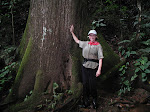So what is a “Charral” anyway?
I’m pondering this word – Charral, which our Costa Rican Forestry Engineer used to describe areas of old pasture land. Soon after we bought the Finca, we decided to stop cutting several tracts of pasture land and allow it to revert to forest. As a result, we now have around 18% of the entire 120 acre Finca designated as charral, leaving about 10% as horse pasture and all the rest as forest. Our plan is to increase the percentage of forest from the current 70% of the entire property to up to about 90%, by regenerating forest from the six charrales.
My primary purpose in starting this blog is to share the journey of natural regeneration of charrales surrounded by forest. Many people here in Costa Rica have an interest in reforesting tracts by planting trees on once agricultural land by succession planting – basically trying to mimic natural regeneration by establishing fast growing R species before introducing hardwood K species into the mix.
My interest is in natural forest regeneration without human intervention over a period of 15 plus years. This is possible at Finca El Tigre because it is part of a government protected area known as Zona Protectora El Rodeo, supposedly the only remnant of primary forest left in the Central Valley of Costa Rica. The forest at Finca El Tigre is a combination of both young and old forest. We have found more biodiversity in the young forest, with birds bringing in seeds from areas on both the Atlantic and Pacific sides of the country. The old forest has mostly remnant species left uncut when cattle once grazed most of the entire area. About 50-60 years ago, the owners removed cattle from part of the Finca and the old forest regenerated quickly. About 80% of the old forest is made up of HUGE remnant trees left uncut: Cedro amargo, Cedro bateo, Ceiba, Chapernos, Chilamate, Espavel, Gallinazo, Guanacaste, Guacimo Colorado, Hule, Jobo, Lagartillos, Lorito, Higuerones, Jabillo, Madrono, Mangle de Rio, Ojoche, Pochote, Quebracho, Sura, Yos, Yuco. Then about 20 years ago, after the entire area was designated by the Costa Rica Government as a ‘Protected Zone’, the previous owners stopped cattle grazing on a large part of the rest of the Finca and this area quickly reverted to a young secondary forest with huge biodiversity (we are still in the process of completing an inventory of flora & fauna). The secondary forests surround the charrales and pasture areas, which were used for light cattle grazing up until the time we bought the Finca in 2005.
Thus, all of the biodiversity surrounding the charrales will provide a good amount of plant material over the years as the charrales revert to forests. Each charral is surrounded by different forest vegetation. For example, the Tigre Hill Charral is located adjacent to a forest of hardwood trees such as: Cocobolo, Guapinol, Mora (Maclura) and Guayacan (Acosmium). Then there’s the Stable Charral, which is located next to a lot of Cenizaro and Guachipelin trees, among many others and so on for each of six charrales.
Twice a year, I’m taking pictures of each charral and noting the changes and will continue doing this for the next 15 years. My only intervention is to plant some hardwoods no longer extant in this forest along the edge of the charrales as well as in small clearings left from fallen trees in the younger growth forest. I will not have any idea of what’s going on in the center of the charrales for the next few more years until the faster growing trees begin shading out all the herbaceous material and improve ground visibility. For now, the charrales are all impenetrable masses of vegetation teaming with insects and who knows what else.
So how do we call Charral in English? I haven’t found a web dictionary that can define the word in Spanish, much less translate it into English! This seems to be a uniquely Spanish word used here in the tropics. Infojardin.net defines it thusly in Spanish:
Charral
Área regenerada del bosque secundario en tierras en las cuales la vegetación arbórea había sido eliminada en gran parte; incluye también a zonas en proceso de degradación de la masa forestal, partiendo de los bosques densos, a bosques sujetos a extracción de las mejores especies, y eliminación de ejemplares de porte arbórea quedando la vegetación más baja o sotobosque (según Maldonado 1997).
And so… Charral is perhaps best defined as a tract of tropical land in the process of reverting from agricultural to forest or (sadly) vice versa.
I like the word charral because it conjures up the concept of dynamic transformation, of real life plant succession, of an emerging forest. I like wandering the charrales and just witnessing the continuous changes. Everyday I see something new just by peering into the edge – here a new Guachipelin sapling, there a Guazuma popping up through the Mozote. Most visitors prefer the forest trails and gazing at the big trees. The forest is always a spiritual sanctuary but the charral is also very special. It brings the promise of what’s to come.
Subscribe to:
Post Comments (Atom)


No comments:
Post a Comment